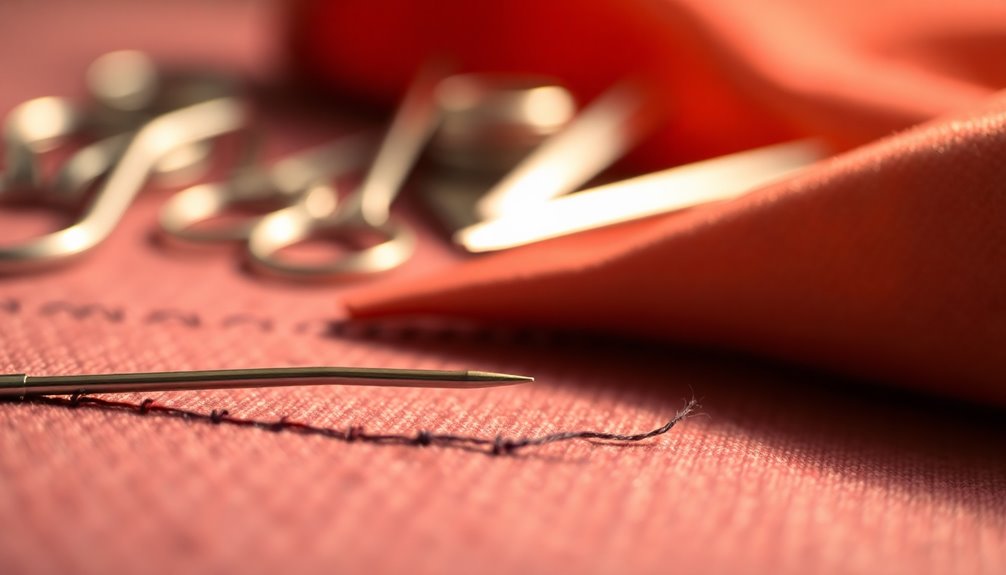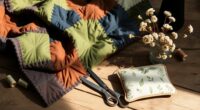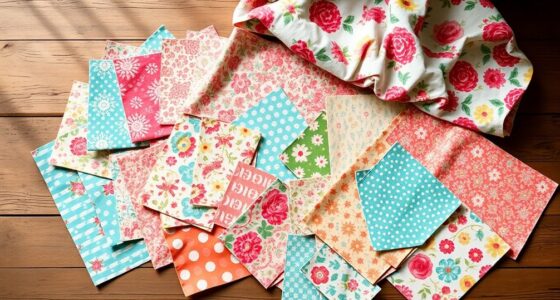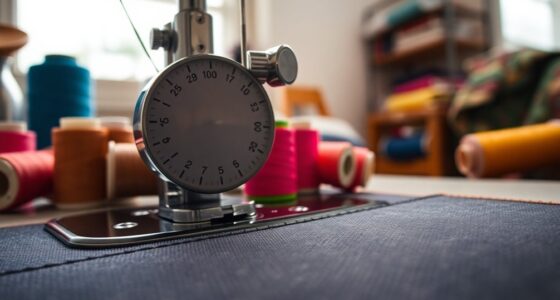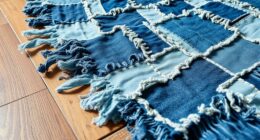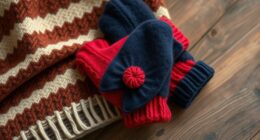Yes, hand sewing needles can get dull over time, especially with frequent use. If you sew for 8-10 hours, it's a good idea to check their sharpness. Dull needles cause skipped stitches and uneven seams, making your projects frustrating. You can enhance your sewing experience by using sharp needles, which glide easily through fabric and reduce strain on your hands. Keep an eye out for signs of dullness to maintain peak performance. There's more to discover about needle care!
Key Takeaways
- Yes, hand sewing needles can get dull over time due to friction against fabric and thread, impacting performance.
- Dull needles lead to skipped stitches, uneven seams, and increased strain on hands while sewing.
- Quality needles made from high-grade steel retain sharpness longer, enhancing durability and performance.
- Regular inspection and replacement every 8-10 hours of use ensure optimal sewing quality and experience.
- Proper storage and cleaning of needles can prolong their lifespan and maintain sharpness for better sewing outcomes.
Understanding Needle Dullness
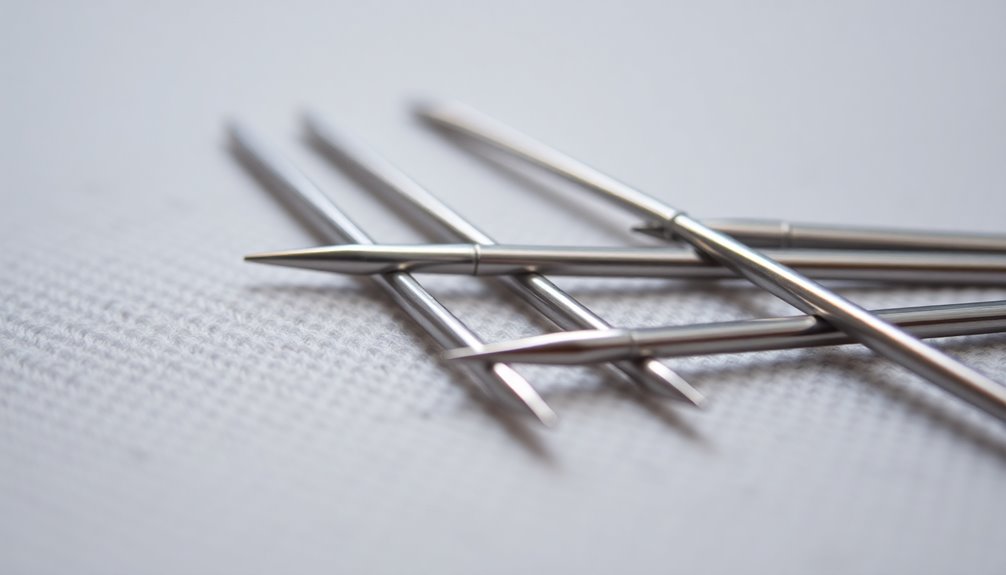
Needle dullness can greatly affect your sewing projects. When your hand sewing needles become dull, you may notice skipped stitches and uneven seams, which can ruin the quality of your work.
This dullness often arises from friction against fabric, especially with heavier materials and thicker threads. Regular use for about 8-10 hours usually means it's time to replace your needle to maintain ideal performance.
Factors like needle quality and fabric type also influence how quickly a needle dulls—high-quality steel needles stay sharper longer.
Practicing regular inspection for signs of dullness, such as resistance when sewing or visible damage, is essential. Keeping your needles sharp guarantees a smoother sewing experience and prevents unnecessary fabric damage.
Importance of Using Sharp Needles
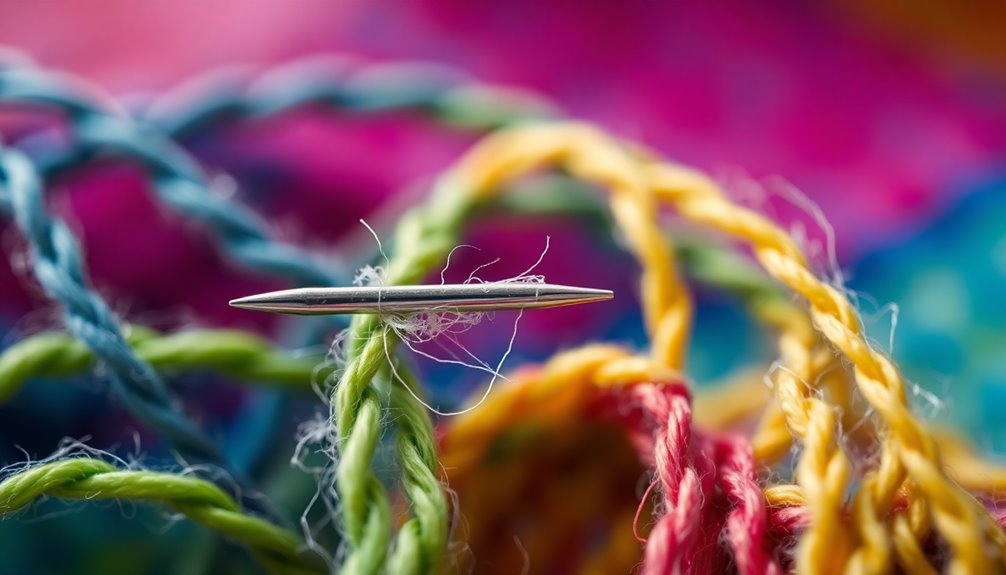
Using sharp needles is essential for enhancing stitch quality, as they glide effortlessly through fabric without causing damage.
When you keep your needles sharp, you'll notice improved sewing comfort and a significant reduction in skipped stitches.
Plus, sharp needles help prevent unnecessary strain on your hands and wrists, making your sewing experience much more enjoyable.
Enhanced Stitch Quality
When you opt for sharp hand sewing needles, you're setting the stage for smoother stitching and enhanced stitch quality.
Using sharp needles minimizes resistance, reducing strain on your hands and wrists during long sewing sessions. Dull needles, on the other hand, can lead to uneven stitches, compromising your project's quality.
To maintain peak performance, consider these four tips:
- Regular Replacement: Change your needles after 8-10 hours of use.
- Quality Needles: Invest in trusted brands like John James or Bohin.
- Needle Maintenance: Keep your needles clean and properly stored.
- Stitching Accuracy: Use sharp needles for precise results.
Reduced Fabric Damage
Choosing sharp hand sewing needles considerably reduces the risk of fabric damage during your projects. Dull needles increase resistance when stitching, leading to pulling or distorting the material. This can result in snagged threads and uneven stitches, heightening the chance of tears.
By using high-quality, sharp needles, you enhance stitching accuracy and guarantee clean, precise work. Sharp needles glide smoothly through fabric, preventing unwanted holes or frayed edges that often accompany dull needles.
To maintain peak sharpness and minimize wear and tear, it's wise to replace your needles every 8-10 hours of use. Prioritizing sharp needles not only protects your fabric but also contributes to a more enjoyable sewing experience with reduced fabric damage overall.
Improved Sewing Comfort
A sharp hand sewing needle can make all the difference in your sewing comfort. Using good quality needles, like those from John James, guarantees you enjoy a comfortable sewing experience.
Dull needles can cause resistance, leading to cramping and fatigue. To maintain improved sewing comfort, consider these tips:
- Replace dull needles every 8-10 hours to prevent snags and uneven stitches.
- Invest in sharp hand sewing needles for better stitch accuracy.
- Regular needle maintenance keeps your tools in top shape.
- A smoother sewing experience enhances your creative expression.
Identifying Signs of Dull Needles
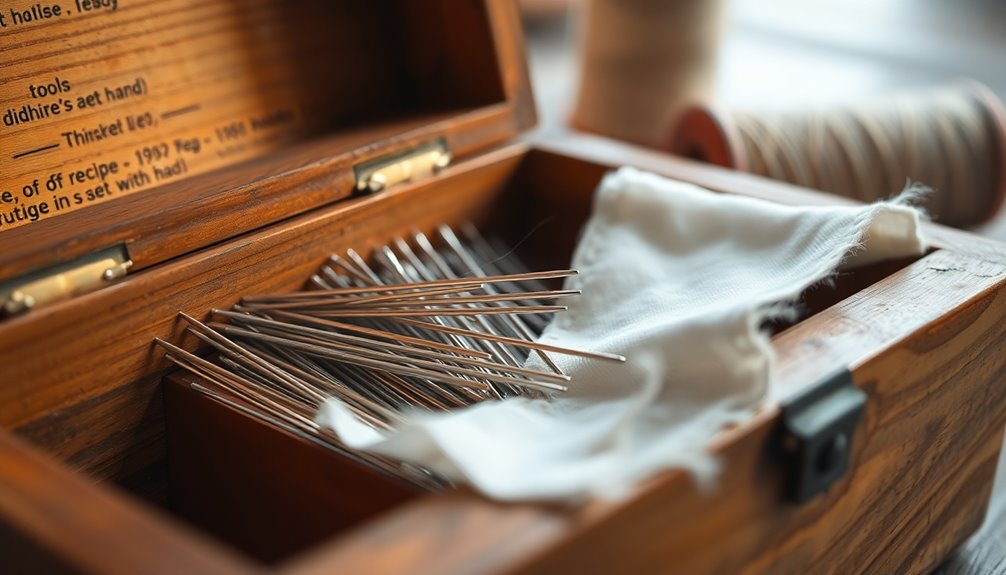
When you're sewing, it's essential to recognize the signs of a dull needle.
You might notice it dragging through fabric, making stitches uneven or causing thread snagging.
Regular visual inspections can help you spot issues like burrs or bends, ensuring your needle stays sharp for peak performance.
Needle Performance Indicators
Although you mightn't notice it at first, identifying signs of dull hand sewing needles is essential for maintaining the quality of your stitching.
Dull needles can lead to uneven stitches and increased fabric damage, so keep an eye out for these indicators:
- Snagging Threads: If threads catch or snag frequently, your needle may be dull.
- Increased Resistance: Noticeable drag when pushing the needle through fabric signals dullness.
- Skipped Stitches: If stitches are uneven or skipped, it's time for inspection.
- Visible Damage: Bent or burr-developing needles should be replaced promptly.
Regular cleaning can help, but don't hesitate to replace your needles to guarantee peak performance.
Your stitching deserves it!
Visual Inspection Tips
To guarantee your hand sewing needles remain effective, regularly conduct a thorough visual inspection.
Start by checking for physical indicators like bent tips or burrs along the needle shaft. Pay attention to the sharpness when piercing fabric; if you notice any signs of dullness, it's time to replace your needle.
A dragging sensation when pulling the needle through fabric often means the needles become dull and need to be changed. Additionally, if the needle is snagging threads during stitching, this can affect the quality of your work.
Always inspect your needles under good lighting to ascertain you can clearly identify any wear or damage. Regular checks will keep your sewing projects running smoothly.
Factors Influencing Needle Sharpness
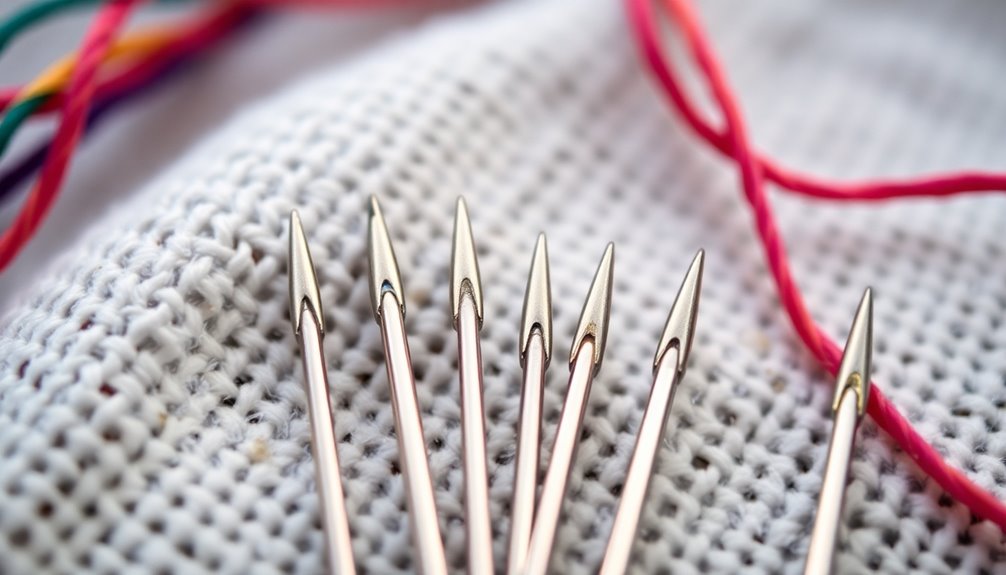
The sharpness of a hand sewing needle is primarily influenced by several key factors that you should consider.
When you understand these factors, you can guarantee your needle stays sharp longer.
- Quality of the needle: Higher-quality steel needles retain sharpness better than lower-grade options.
- Type of fabric: Heavy fabrics can dull the needle more quickly than lighter materials.
- Thread thickness: Using thicker thread increases friction against the needle, leading to faster dulling.
- Sewing techniques: Improper sewing techniques, like forcing the needle through tough materials, can accelerate sharpness loss.
Being aware of these factors helps you prevent situations where your needle is dull and guarantees that your sewing projects run smoothly. Additionally, maintaining your sewing tools is essential for optimal performance. Regularly checking and understanding how to clean sewing tools can significantly extend their lifespan and ensure precise results. By taking the time to care for your equipment, you can enhance both your sewing experience and the quality of your finished projects.
Best Practices for Needle Maintenance
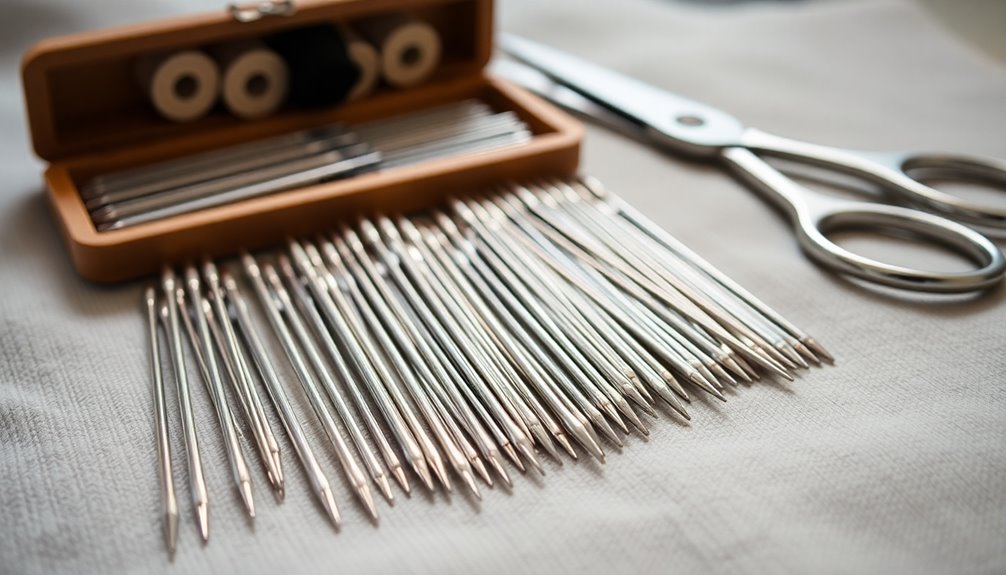
Maintaining your hand sewing needles is essential for achieving the finest results in your projects. To guarantee peak performance, remember to regularly replace your needles after 8-10 hours of use. Store your needles organized by size and type in dedicated needle cases, making them easy to access. Clean your needles periodically to remove oils and grime that can cause drag. Always opt for high-quality needles from reputable brands, as they retain sharpness longer. Additionally, test different needle types on scrap fabric to find the best match for your specific project.
| Practice | Description |
|---|---|
| Replace | Change needles every 8-10 hours |
| Store | Use needle cases for organization |
| Clean | Wipe needles to remove oils and grime |
| Test | Experiment with needle types on scraps |
Tips for Choosing and Storing Needles
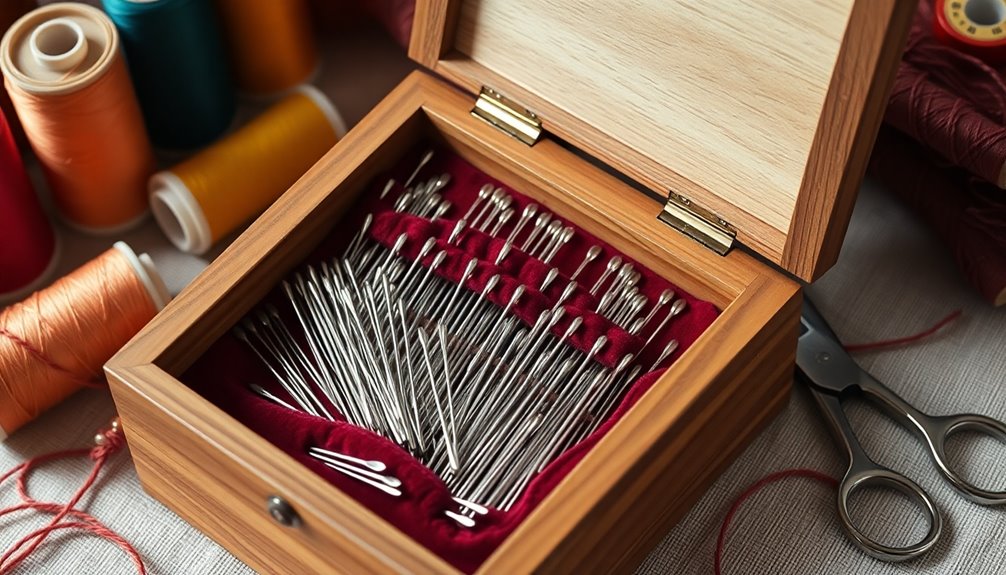
Choosing and storing your hand sewing needles wisely can greatly impact your stitching experience. Here are some tips to keep your needles organized and in top shape:
- Organize needles by size and type in designated cases to prevent confusion—use a red case for No. 7 Sharps and a green case for No. 11 Milliners.
- Store needles in a dry, cool place to maintain sharpness and prevent rusting from moisture and heat.
- Regularly inspect needles for signs of wear like dullness or bending, and replace them promptly.
- Invest in high-quality needle brands such as John James or Richard Hemming & Sons to guarantee durability and performance, especially when using quality thread.
Consider using a needle book or magnetic case for portable storage to keep your machine needles secure.
Frequently Asked Questions
How Long Do Hand Sewing Needles Last?
Hand sewing needles typically last around 8 to 10 hours of active use.
However, this can vary depending on the fabric you're working with; heavier materials tend to dull needles faster.
It's important to regularly inspect your needles for signs of wear, like bending or snagging.
If you choose high-quality needles, like those from John James, you'll find they maintain their sharpness longer, giving you a better sewing experience overall.
Do Hand Sewing Needles Get Dull?
Yes, hand sewing needles do get dull over time.
When you sew, friction against fabric and materials can wear down the needle's sharpness. You might notice signs like dragging through the fabric or snagging threads, which indicate it's time for a replacement.
To keep your sewing smooth, consider changing your needle after 8-10 hours of use. Investing in high-quality needles can also help maintain their sharpness longer, enhancing your sewing experience.
Do Needles Get Dull Over Time?
Yes, needles do get dull over time. As you sew, friction against fabric and thread causes wear, leading to a loss of sharpness.
You might notice your needle snagging or dragging through material, making it harder to work. To maintain your sewing quality, keep an eye on your needles and replace them regularly, especially if you're using them for extended periods.
This'll help you avoid frustration and keep your projects looking their best.
Do Sewing Needles Wear Out?
"All good things must come to an end." Yes, sewing needles do wear out over time.
As you sew, the friction against fabrics gradually dulls the needle. You'll notice signs like bending, snagging, or increased resistance when working through materials.
To maintain your stitching quality, it's vital to inspect your needles regularly and replace them as needed.
Conclusion
So, don't let your sewing dreams unravel because of dull needles! A sharp needle is your trusty sidekick, making every stitch feel like magic. Keep an eye out for those pesky signs of dullness, and treat your needles with the love they deserve. With a little care and the right storage, you'll have a needle that lasts longer than your grandma's favorite pair of scissors! Go ahead, release your creativity without the frustration of a dull blade!
